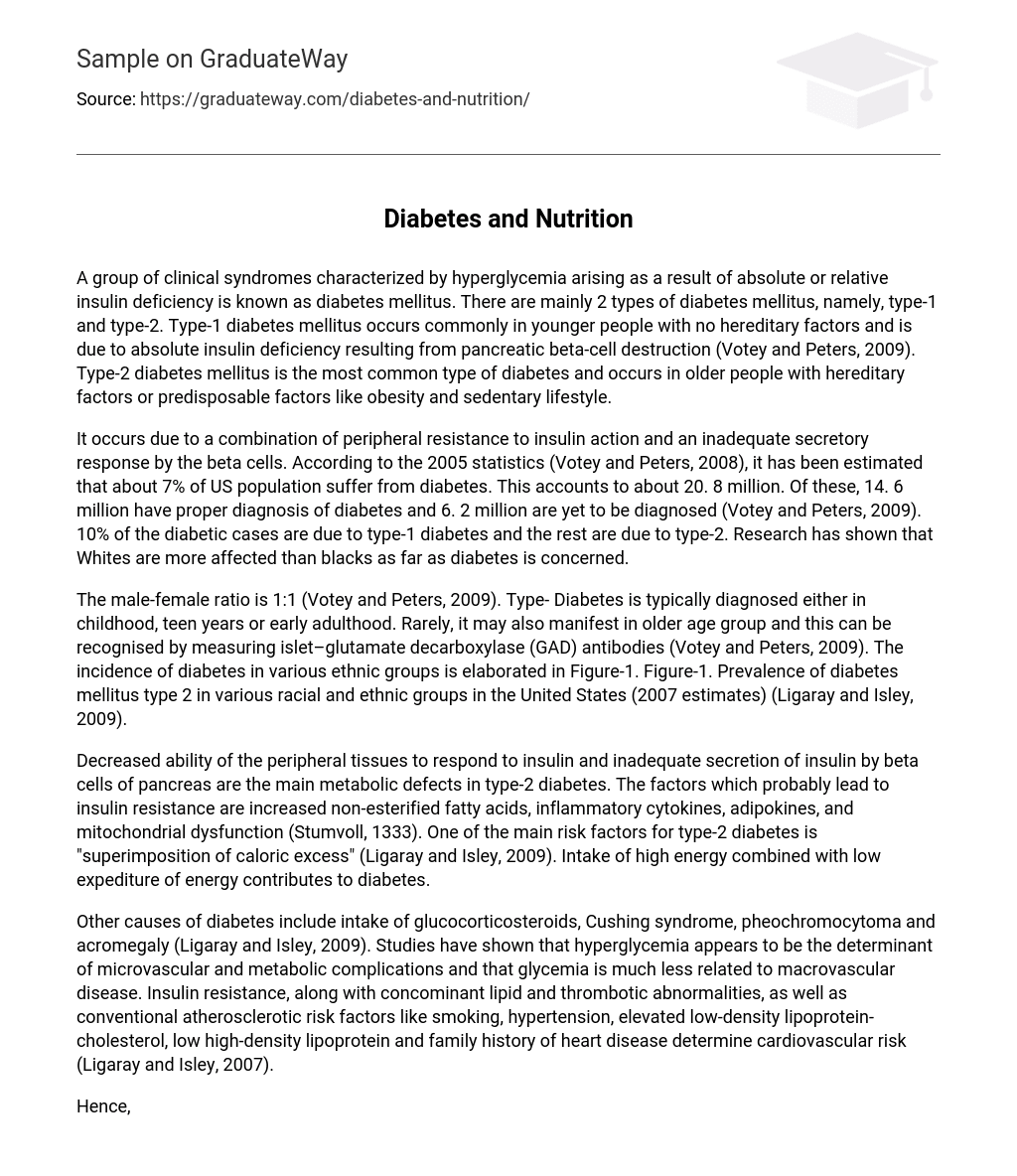A group of clinical syndromes characterized by hyperglycemia arising as a result of absolute or relative insulin deficiency is known as diabetes mellitus. There are mainly 2 types of diabetes mellitus, namely, type-1 and type-2. Type-1 diabetes mellitus occurs commonly in younger people with no hereditary factors and is due to absolute insulin deficiency resulting from pancreatic beta-cell destruction (Votey and Peters, 2009). Type-2 diabetes mellitus is the most common type of diabetes and occurs in older people with hereditary factors or predisposable factors like obesity and sedentary lifestyle.
It occurs due to a combination of peripheral resistance to insulin action and an inadequate secretory response by the beta cells. According to the 2005 statistics (Votey and Peters, 2008), it has been estimated that about 7% of US population suffer from diabetes. This accounts to about 20. 8 million. Of these, 14. 6 million have proper diagnosis of diabetes and 6. 2 million are yet to be diagnosed (Votey and Peters, 2009). 10% of the diabetic cases are due to type-1 diabetes and the rest are due to type-2. Research has shown that Whites are more affected than blacks as far as diabetes is concerned.
The male-female ratio is 1:1 (Votey and Peters, 2009). Type- Diabetes is typically diagnosed either in childhood, teen years or early adulthood. Rarely, it may also manifest in older age group and this can be recognised by measuring islet–glutamate decarboxylase (GAD) antibodies (Votey and Peters, 2009). The incidence of diabetes in various ethnic groups is elaborated in Figure-1. Figure-1. Prevalence of diabetes mellitus type 2 in various racial and ethnic groups in the United States (2007 estimates) (Ligaray and Isley, 2009).
Decreased ability of the peripheral tissues to respond to insulin and inadequate secretion of insulin by beta cells of pancreas are the main metabolic defects in type-2 diabetes. The factors which probably lead to insulin resistance are increased non-esterified fatty acids, inflammatory cytokines, adipokines, and mitochondrial dysfunction (Stumvoll, 1333). One of the main risk factors for type-2 diabetes is “superimposition of caloric excess” (Ligaray and Isley, 2009). Intake of high energy combined with low expediture of energy contributes to diabetes.
Other causes of diabetes include intake of glucocorticosteroids, Cushing syndrome, pheochromocytoma and acromegaly (Ligaray and Isley, 2009). Studies have shown that hyperglycemia appears to be the determinant of microvascular and metabolic complications and that glycemia is much less related to macrovascular disease. Insulin resistance, along with concominant lipid and thrombotic abnormalities, as well as conventional atherosclerotic risk factors like smoking, hypertension, elevated low-density lipoprotein-cholesterol, low high-density lipoprotein and family history of heart disease determine cardiovascular risk (Ligaray and Isley, 2007).
Hence, the goals in the treatment of diabetes are to eliminate symptoms, decrease the risk of microvascular complications through control of glycemia and blood pressure and also through other means like lipid control, smoking cessation and lifestyle modification. Dietary management is the most crucial part of management of diabetes. The dietary management must constitute modifications of currently eating foods. The first step in dietary management is caloric restriction. After this is taken care of, individual preferences are given importance.
Modest restriction of simple sugars and saturated fatty acids is recommended (Ligaray and Isley, 2007). Complications due to diabetes may be avoided by receiving appropriate medical care from a physician-coordinated team which includes physicians, nurse practitioners, physician’s assistants, nurses, dietitians, pharmacists, and mental health professionals with expertise and a special interest in diabetes (American Diabetes Association, 2004). Diabetes self-management education is an integral component of care, the components of which are: )
Glycemic control: This is fundamental to the management of diabetes. Research has shown that improved glycemic control is associated with sustained decreased rates of retinopathy, nephropathy, neuropathy (DCCT/EDIC Research Group, 2000, quoted in American Diabetes Association, 2004) and cardiavascular complications (American Diabetes Association, 2004). The goal should be to achieve glycosylated hemoglobin of <7%. Self-monitoring of blood glucose will be useful in achieving good glycemic control in Josef once he is started on insulin therapy. )
Medical Nutrition Therapy and physical activity: Diabetic patient must be educated about medical nutrition therapy (MNT) and life style modification. MNT is an integral component of diabetes management and diabetes self-management education. It involves a nutrition assessment to evaluate the patient’s food intake, metabolic status, lifestyle and readiness to make changes, goal setting, dietary instruction and evaluation. Along with this, monitoring of glucose and A1C, lipids, blood pressure, and renal status is essential.
Regular exercise is essential to improve blood glucose control, reduce cardiovascular risk factors, contribute to weight loss, and improve well-being. Blood pressure must be maintained below 130/80mmHg. Diabetic patients must be advised lifestyle and behavioral therapy alone for a maximum of 3 months and then, if targets are not achieved, in addition, be treated with pharmacological agents that block the renin-angiotensin system (American Diabetes Association, 2004). Lipid management should be aimed at lowering LDL cholesterol, raising HDL cholesterol, and lowering triglycerides.
Target lipid levels are <2. 6 mmol/l of LDL, <1. 7 mmol/l levels of triglycerides and >1. 1 mmol/l of HDL (American Diabetes Association, 2004). This should be achieved by exercise, MNT and drugs. Those who smoke and consume alcohol must stop smoking and minimize alcohol consumption. c) Diabetic patients must take up regular screening tests for early detection of nephropathy, neuropathy and cardiac problems. These include regular check-ups of blood pressure, lipid profile, exercise ECG, microalbumunuria, fundoscopy and annual foot examination (American Diabetes Association, 2004).





